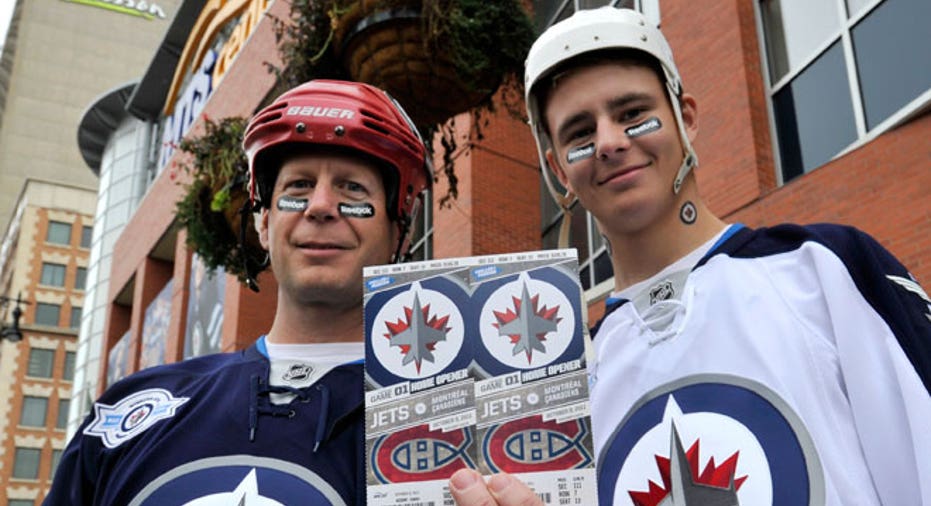Puck Crazy: Is the NHL Recession Proof?

Like most of corporate America, the professional sports world has been squeezed by a tougher spending environment caused by the 2008 financial crisis.
While baseball is America’s pastime and the NFL generates almost $10 billion in annual revenue, a new analysis surprisingly suggests the NHL may be the most recession-proof of the Big Four sports leagues.
In the face of a 17% hike in ticket prices through last season and a painful work stoppage this year, pro hockey is the only sport to enjoy higher attendance now than before the downturn.
According to ConvergEx, the NHL also sports a negative correlation between attendance and economic growth, the highest positive correlation between attendance and ticket prices and strong price elasticity.
“I think what makes the NHL a little safer is the depth of loyalty of their fans,” said Robert Boland, a sports business professor at NYU.
Besides a fiercely loyal fan base that has endured several recent work stoppages, the NHL also has a more affluent group of core customers.
Rising Prices Can’t Keep Puckheads Away
Citing league data, ConvergEx said hockey aficionados have a mean household income of $104,000, 8.1% higher than MLB’s $96,200 and 10% stronger than the NFL’s $94,500. Likewise, almost half -- 47.3% -- of NHL fans have salaries above $75,000, compared with 42.5% for MLB and 41.2% for NBA and NFL.
Hockey fans also tend to be more male and younger than their peers in other sports: 64% male and 33% are ages 18-34.
"The hockey fan may be a little more resilient and connected to his or her teams than other sports."
To support their conclusion about the NHL’s ability to weather turbulent economic times, ConvergEx analyzed attendance and ticket price data over the past decade.
According to the report, NHL attendance climbed 1.1% between 2008 and 2012 -- the only sport to grow attendance over that span -- even though the average ticket price jumped to $57.10 in the 2011-2012 from $48.72 in 2007-2008. Even after ticket prices soared more than 5% during each of the last two seasons, attendance still rose 0.3% and 1.9%, respectively.
In contrast with the NHL’s 17.2% leap in prices, average NBA ticket prices have declined 4% since 2000 to $48.48. Despite the cheaper seats, attendance is off 2.7% since peaking in 2007.
Attendance for pro baseball teams has slid 5.9% since 2008, while ticket prices are up by an average of 6% over that span.
Even the NFL, which is by far the most popular and lucrative of the four major sports, has seen attendance slip 1% since 2008 as ticket prices have climbed 8.6% and more fans stay home to watch Red Zone in HD.
Recession Proof?
Baseball, which needs to fill seats for 81 home games, is the most susceptible to price changes. The MLB is the only major sports league to have a negative correlation (-0.10) between ticket prices and attendance over the past years, ConvergEx said.
But hockey fans are the least likely to be kept away by prices: the NHL enjoys a 10-year correlation of +0.22 between attendance and ticket prices, meaning fans go more when ticket prices are higher. By comparison, the NBA and NFL have correlations of +0.21 and +0.12, respectively.
Likewise, the NFL (0.02) and NHL (0.04) can boast of near-zero price elasticity, which is calculated by dividing the yearly fluctuation in attendance by the annual change in average ticket prices
“In general a price elasticity near zero indicates that demand is nearly completely independent of price,” ConvergEx wrote.
At the opposite end of the spectrum, ConvergEx said MLB’s 10-year price elasticity of 1.77 “suggests that for every 1% rise in price, demand for tickets will fall by 1.77%, all else equal. Not a good revenue-enhancing strategy in this sport.”
The analysis also shows fan decisions to buy tickets don’t seem to be influenced by the overall economy.
Over the past decade, hockey had a -0.30 correlation between gross domestic product and attendance, compared with correlations of +0.68 for baseball, +0.53 for the NFL and +0.18% for the NBA.
That means owners of MLB and NFL teams have less room to massage ticket prices higher during times of economic distress.
“The hockey fan may be a little more resilient and connected to his or her teams than other sports, particularly the ones that rely on corporate fans," said Boland.
Life After the Lockout
It’s worth pointing out that the ConvergEx analysis only includes the last full season, meaning impact from the current post-lockout season aren’t included.
However, data from ESPN.com indicate the NHL isn’t hurting from a post-lockout hangover.
Average attendance for 2013 is up 1.4% to a solid 17,701 and venues are averaging 96.7% of capacity despite bad press over the lockout, which shrank the season to just 48 games.
Seventeen of the league’s 30 teams have enjoyed 100% or greater home attendance so far this year, led by the undefeated (in regulation) Chicago Blackhawks who are drawing an NHL-best 21,524 fans per game. Just two franchises have sub-80% attendance records: the Phoenix Coyotes and Columbus Blue Jackets.
The NHL also has an inherent advantage when comparing attendance and GDP because the league sports seven teams from Canada, which suffered less than the U.S. from the economic downturn. By comparison, the NBA and MLB have just one team a piece from North of the Border and the NFL has none.
From an economic standpoint, the NHL’s resilience paints an optimistic picture about U.S. consumers, at least upper-middle class ones.
“Despite evidence that younger, early-career professionals are really struggling in this job market, ‘yuppies’ appear to be on solid footing,” ConvergEx said. “That or they just really love their hockey.”